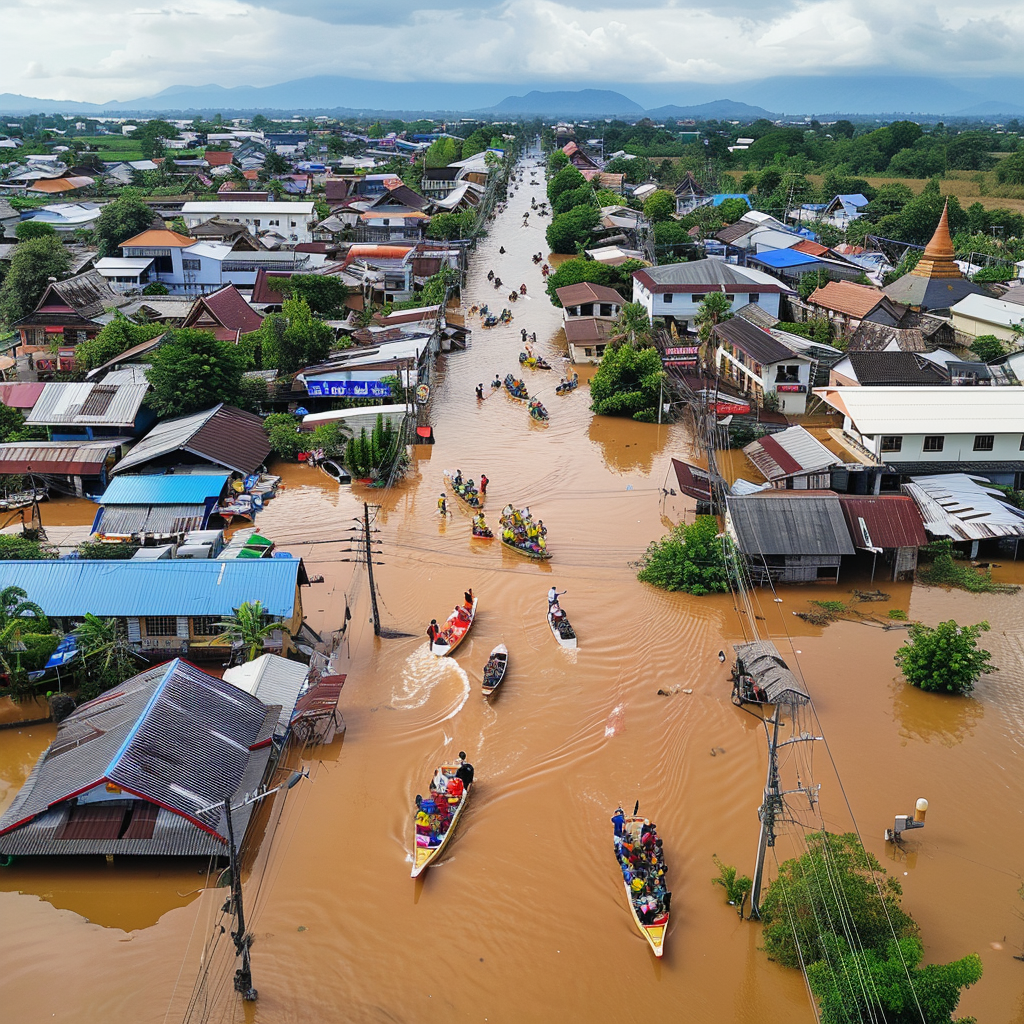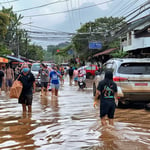Help is on the way! Prime Minister Paetongtarn Shinawatra recently chaired a crucial meeting to roll out a relief plan for flood victims in Chiang Rai. This key assembly took place at the bustling Mae Fa Luang-Chiang Rai International Airport on Friday, showcasing the government’s commitment to tackle the disaster head-on (Photo: Government House).
Good news followed suit as the government initiated the first round of compensation for more than 3,600 households, who found themselves severely affected by the relentless flooding in Chiang Rai. Speaking on behalf of the Interior Ministry, spokeswoman Traisulee Taisaranakul revealed that the cabinet had given the green light on September 17 to allocate a substantial budget of 3.04 billion baht for nationwide flood victim compensation.
The responsibility of distributing these funds has fallen to the Interior Ministry. Chaiwat Junthiraphong, the director-general of the Department of Disaster Prevention and Mitigation, announced that compensation payments were successfully transferred to the bank accounts of 3,623 flood-stricken households spanning three districts in Chiang Rai on Friday. The affected areas included 3,305 households in Muang district, 222 in Mae Sai, and 96 in Khun Tan. Households under floodwater for less than 30 days were allocated 5,000 baht each, while those submerged for 30 to 60 days were given 7,000 baht. Households enduring the waters for over 60 days received 9,000 baht in relief.
The overflow of runoff from Doi Suthep further exacerbated the situation at Chiang Mai University on Friday morning, adding to the city’s already dire flood circumstances. Social media buzzed with images depicting floodwater overtaking areas of the university campus located at the base of the scenic Doi Suthep mountain. Kuakul Manasamphansakul, the provincial irrigation chief, indicated that rain on Doi Suthep had aggravated the runoff situation.
The university, situated in Muang district, responded by closing several flood-affected roads and advising staff and students to relocate their vehicles to elevated grounds, although movement around the campus remained largely unaffected. This predicament added to the cumulative struggles Chiang Mai has faced since Tuesday, as unrelenting rainfall compounded the city’s problems, despite its distance from the Ping River.
The Ping River’s water level remained concerning, measuring 4.23 meters at Naowarat Bridge at 9am on Friday, a slight increase from 4.19 meters a couple of hours earlier. Chiang Mai Municipality confirmed that several downtown areas, including the railway station, remain inundated. Estimates from the local irrigation office suggested approximately 3 million cubic meters of floodwater inundated the city, with an anticipated two days needed to fully drain the water out.
Despite the overwhelming floods, Chiang Mai airport continues to operate. Travelers have been directed to navigate to the airport via Highway 11, also known as the Super Highway, and Nimmanhaemin Road. The Prime Minister showed a hands-on approach by leading a delegation of cabinet ministers and officials to Chiang Rai for flood inspections on Friday. She is also slated to visit the flood-hit areas in Chiang Mai on Saturday.
In the meantime, the Office of the National Water Resources (ONWR) has sounded the alarm, cautioning residents in flood-prone regions of Bangkok and five other provinces about the potential for flooding. This warning stems from continuous rainfall, river runoff from the North, and rising high tides anticipated until October 2.
The ONWR has projected that increasing river water levels could severely impact low-lying areas along major rivers such as the Chao Phraya River, Mae Klong River, and Thachin River. The prediction spells trouble for riverside communities, especially those situated outside flood embankments in Bangkok, Samut Songkhram, Samut Sakhon, Nakhon Pathom, Nonthaburi, and Samut Prakan.
Echoing this sentiment, Watchara Kraisai, the director of the 12th Irrigation Office, indicated that the Royal Irrigation Department has upped the ante by increasing the water outflow at the Chao Phraya Dam in Chai Nat to 1,800 cubic meters per second, amid higher water volumes streaming from the North. Consequently, downstream river water levels from Chai Nat to Ayutthaya are expected to rise by about 30cm. As such, riverside communities located outside flood embankments and those in low-lying regions along the Chao Phraya River and Noi River are urged to brace for the rising waters.


















It’s great to see Paetongtarn Shinawatra taking charge of the flood relief operations. The compensation seems fair given the circumstances.
Sure, it’s good to see some action, but does anyone else feel like these payouts are just a band-aid solution?
What did you expect, Rick? It’s not like they can rebuild everyone’s homes overnight!
Exactly, Mai. The compensation might not be perfect, but it’s a start and people need immediate support.
They should focus more on long-term prevention rather than just compensating after the fact.
You’re right, Takashi. Both immediate support and long-term solutions are necessary to effectively manage such disasters.
Long-term prevention means more taxes and government involvement. Are you ready for that?
How come Chiang Mai is always the one hit hardest by these floods each year?
Blame it on poor urban planning and relentless deforestation, Jasmine.
Fernando is right. Environmental degradation is the underlying cause of many of these disasters.
Is the government doing enough to assist in Chiang Mai?
I think they’re stretched thin since they have to deal with so many affected areas at once.
It’s complicated. They have priorities and sometimes rural areas get less attention compared to urban centers.
This is why decentralization is important. Local governments should have more control and resources to handle such situations.
Interesting perspective, but isn’t decentralization risky, especially for less affluent areas?
The real question is, where’s all this money coming from? More debt for the country?
It’s our taxes paying for it, Joey. More government spending means our pockets get lighter.
That’s what I feared. We need to be more transparent about our spending!
Flooding has always been a problem in Thailand. Isn’t there a more permanent solution?
Good luck with that. The geography and climate make it inevitable. We can mitigate but can’t fully prevent.
Mitigation is a good start. Hopefully, the government allocates funds for infrastructure improvements too.
My family lives in a flood-prone area near the Chao Phraya River. The situation worsens every year!
Stay safe. It’s scary how climate change exacerbates these kinds of events.
I’ve thought of moving, but where else can we go? This is our home.
I hear you. Moving is not an option for many like us.
While flood relief is crucial, we must not forget other essential services that can be disrupted because of these floods.
Chiang Mai has historically been prone to floods. The ancient city planning didn’t account for modern urban sprawl.
Is anyone keeping track of the environmental impact of these floods? The aftermath is devastating for local wildlife too.
Wildlife isn’t the government’s priority when people are losing their homes, Jake.
True, but we can’t ignore the broader ecosystem. Balance is necessary.
Flood victims need more than just money. Psychological support and community rebuilding are also essential.
Exactly! Some people suffer trauma from these events. It’s not just about material loss.
Perhaps NGOs could step in and provide psychological support where the government lacks resources.
I hope the Prime Minister’s visit is not just a publicity stunt. Actions speak louder than words.
It’s easy to criticize, but it does show a level of commitment from the government.
Visits don’t build dams or install drainage systems. Words are cheap!